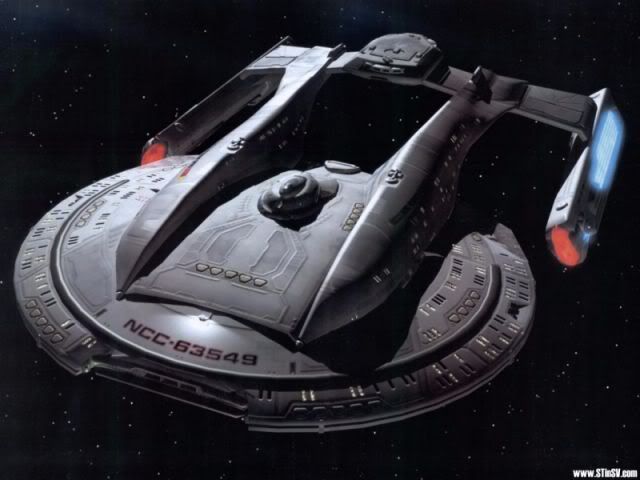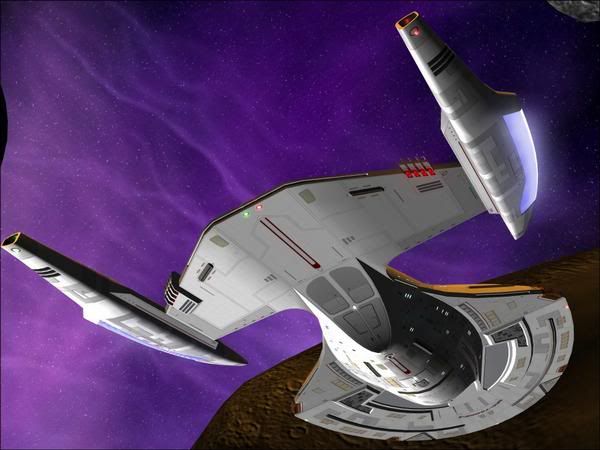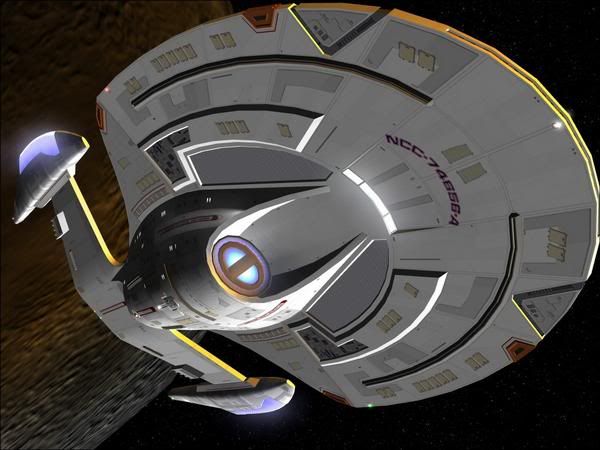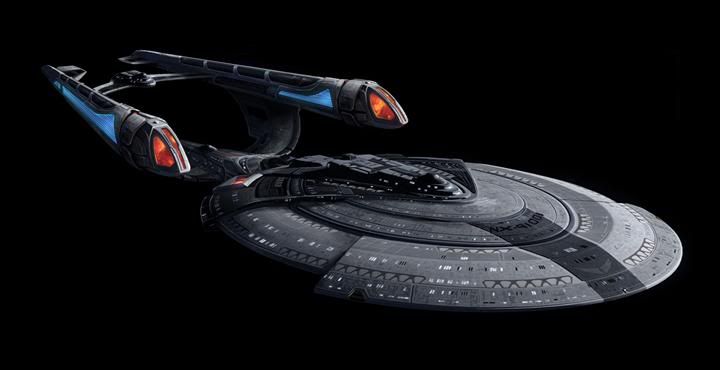- By Jake Sisko
Stardate 64044.4 (Sat, Jan 17, 2387 – 10:56)
Loyal readers will remember the series of articles I wrote before and after the Dominion War about the state of Starfleet, and the efforts being made to address serious issues in its function and role. For the last eight months, I’ve been embedded with the crews of three ships in the fleet, both during and after the refits mandated by the Aegis modernization program. I’ve learned a lot on this assignment, and I have a cautious optimism for the future of the Federation in this new era.
The Fujin
On stardate 63294.4, I boarded the Akira-class USS Fujin NCC 63549 for my three-month tour during her shakedown cruise after refit. The ship is every bit as magnificent as she was at her launch some 25 years ago, especially after the upgrades to the ship’s computer, holodecks and crew quarters.
Her captain, Harry Kim, is a soft-spoken, thoughtful man who puts the needs of his crew above his own ego and desires at every turn, but he isn’t to be underestimated, as I discovered from the ship’s XO, Commander Thomas Paris. At lunch in the spacious mess hall on my second day, we shared tales of their time on the legendary USS Voyager over a meal of fresh Belgian waffles, “Harry’s the nicest guy in the quadrant, and he’s my best friend, but you do not want to cross him. I think it’s a trait he picked up from Cap- Admiral Janeway; if he sets his mind to something, you had better go along, or get out of the way.”
I had ordered coffee with my meal, but for some reason, Captain Kim wouldn’t even allow the replicator patterns aboard.
I never saw the Captain’s purported temper on my tour with the Fujin, but I did see the strength of his resolve on the third day aboard. We went to warp out past Jupiter to test out the new engines, and just as we passed warp 9.95, the bulkheads began to vibrate, and the deck plating rattled like the ship was going to fly apart. Captain Kim just watched his readouts, calm as a Risan sunrise, and told the helm to maintain course as the speed rose. The vessel’s ride smoothed out as we reached the ship’s new maximum, but I was still shaking worse than the ship had been. Captain Kim never moved from his seat until we were on our return journey from Proxima some 5 hours later.
Over the next six weeks, I witnessed drill after drill, test after test as the new systems were evaluated, and new procedures were implemented through trial and error across the fleet. In the end, the camaraderie among the crew and officers was the most thrilling part for me; I had a sense that these people knew they were a part of a new era of Starfleet policy, and most of them embraced the new defense-oriented doctrine with gusto. As we rendezvoused with the Intrepid-class USS Mercury NCC 74858-A for the next phase of my assignment, I felt a pang of nostalgia for the friends I made as a child on Deep Space Nine; Captain Kim, Commander Paris and their crew were the sort of people you can really count on, and I wish them the best in this uncertain future.
I captured this image as the Mercury pulled away:

The Mercury
The Intrepid class was once considered the fastest ship in the fleet, before the launch of the USS Sovereign in 7372. Designed as a light exploration vessel or heavy scout, the class proved exemplary during the war, and the USS Voyager survived a 70,000 light year journey home against all odds. Fifteen years after its first voyage, the USS Mercury had seen combat, explored the edge of the Alpha Quadrant, and established first contact with six races, including the Ragnar Imperial Republic, but the greatest mission it had undertaken was about to begin. As only the second ship of the class to receive the radical refit mandated by Starfleet, the Mercury had ended its trials, and spent the last three years on deep patrol along the Romulan border. Now, they had a mission to escort the Federation ambassador to the Klingon Empire to meet with chancellor Martok on Qo’nos. Captain Blikk, a Bolian, kept to himself mostly during the mission, but made sure I had appropriate access for my story.
At this time, I hadn’t seen Worf in nearly ten years, and it was good to see him again. We reminisced about my father, and the good times we shared on the station as the ship sped toward Klingon space at maximum warp. Aboard the Mercury, top speed was nearly as smooth as regular cruise was aboard the Fujin, and not once did the ship feel out of control.
Once at Qo’nos, we remained in orbit for the duration of ambassador Worf’s planned visit, and I became more familiar with the refit of the iconic vessel. Many things had changed, including the luxurious crew accommodations present on the original model. Defiant-style bunks filled the previous quarters, freeing up more internal space for the enhanced weapon systems and power generators. A Defiant-type warp core took up one of the cargo bays now, providing power solely to the pulse phasers mounted on the forward saucer. They had transformed the class into a true patrol frigate and heavy scout.
The attitude of the crew matched the militarized version of the ship, enlisted and officer alike taking turns cleaning the ship top to bottom, while engineering crews checked and rechecked all of the massive power conduits snaking through the Jefferies tubes. It seemed as though they were always on guard, like the whole ship was at a continual yellow alert, even when the status was ‘all clear’.
After a month at Qo’nos, we returned to the Federation, minus the Ambassador; he had decided to remain for the foreseeable future, as he worked to strengthen the alliance that won the Dominion War.
When we reached the Sol system, I disembarked at Utopia Planetia, surrounded by the hulls of brand new designs under construction, but I was still amazed by the Mercury, its class given new life in the Aegis program. I caught a number of images during my stay, and I’ve included a few here:



The Regency
On stardate 63897.7, the latest refit of the Sovereign-class starship left its dock in orbit of Mars, and I was onboard. USS Regency NCC 75222 had completed its Aegis refit six months prior, and had returned for final testing. With all systems performing at peak, we left sector 001, and headed for the Cardassian DMZ. Captain Benteen was a consummate professional, and treated me with utmost respect during my three month stay. The Sovereign was an incredible ship in its time, but recent events have continually proven it to be a relic of an era pre-Dominion War, and unable to compete with newer designs from an array of enemies.
The Regency and its ilk redress these issues in spades. With hulls stripped almost to the frame, the addition of considerable armor, and a modular weapon pod attachment, the new Sovereign is not the idealist’s exploration vessel that launched fourteen years ago. An arsenal of phaser arrays and quantum torpedoes bristle from all angles. She is a predator.
During weapons testing, I was astounded; I cannot divulge specific information, but the tests were impressive to say the least. The upgrades to power generation weren’t as invasive as the ones on the Mercury, but evidence was there. Holodecks were rationed to conserve power for weapon systems, and the new torpedo storage bays were massive.
I cannot comment on the nature of our mission, or the specifics of the ship herself, but I left this morning with a sense of awe, not only at the amazing increase in power these new refits represent, but the ability to prevent another war on the scale of the conflict that nearly consumed our way of life.
This is the only image of the Regency I was able to take:

If war comes again, Starfleet is ready.

